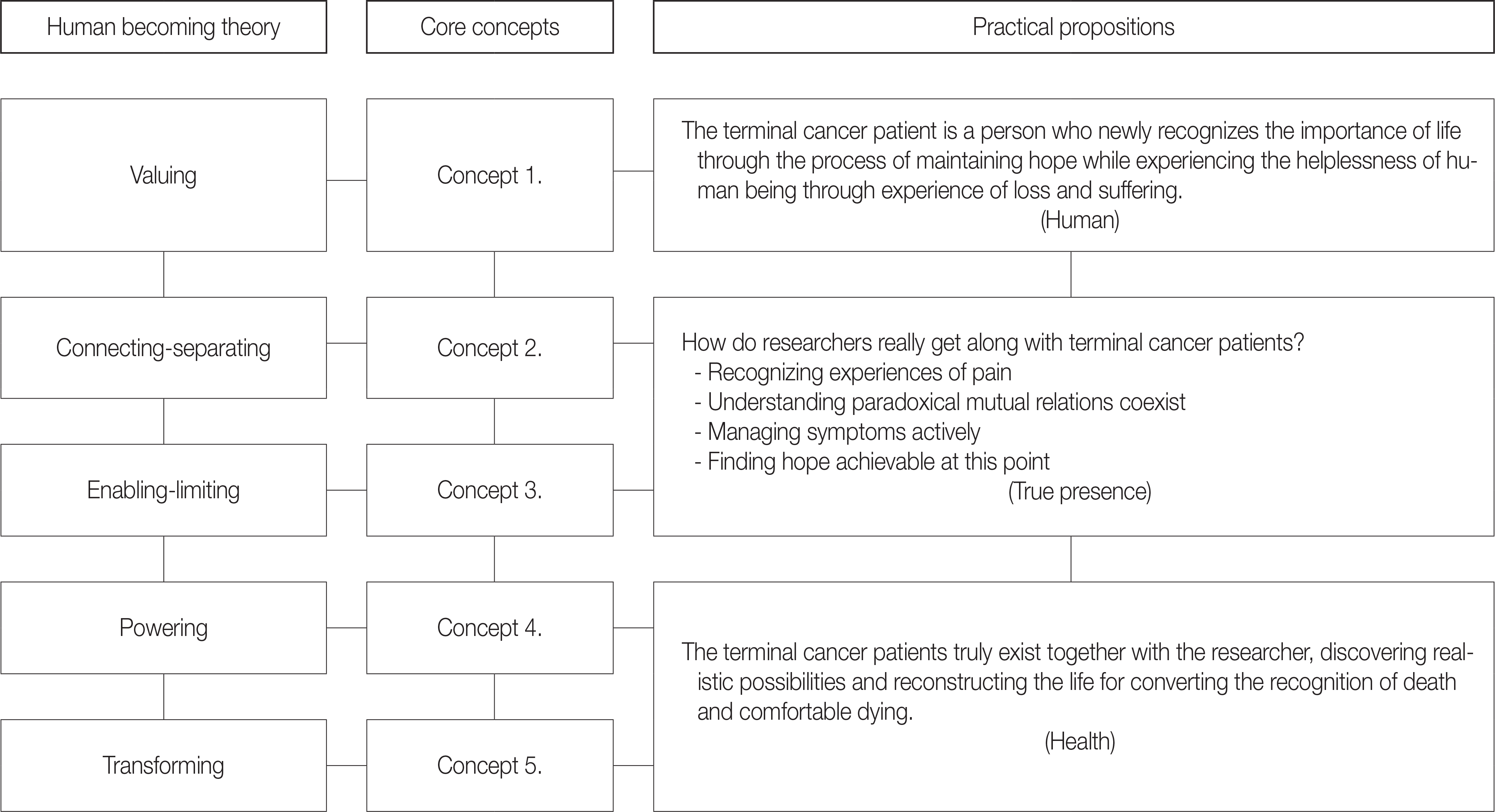초록
Purpose
The purpose of this study was to explore the experience of hope of terminal cancer patients in Korea.
Methods
Seven participants receiving hospice care were interviewed about hope experiences based on Parse's research methodology.
Results
Practical propositions derived from the structure of the hope experience were: Terminal cancer patients are beings newly recognizing the value of their lives by maintaining their hopes while they are experiencing powerlessness due to feelings of loss and distress. Ways of truly being with them are accepting their experience of distress, understanding the existence of paradoxical relationships, active symptom management, and finding hope in the current situation. Through these processes, the patients restructure their remaining lives for peaceful death by changing their perceptions about death. This structure can be interpreted as ‘the hope experience of terminal cancer patients is a process of changing the value of life, overcoming fear of death, enhancing meaning, and transcending.’
Go to : 
REFERENCES
1. Korean Statistical Information Service. Causes of death statistics in 2017 for Korea [Internet]. Available from. http://kosis.kr/statisticsList. [Accessed January 9, 2019].
2. National Cancer Center. Hospice and palliative care in 2017 for Korea [Internet]. Available from. http://hospice.cancer.go.kr. [Accessed January 9, 2019].
3. Hong YH, Moon DH, Lee CS, Lee JR, Lee JH, Kim YJ, et al. Hospice and palliative care for the terminal patients with colorectal cancer. Korean J Hosp Palliat Care. 2007; 10:35–42.
4. Moon JY. Music therapy in hospice care. Korean J Hosp Palliat Care. 2007; 10:67–73.
5. Lee OJ. Lived Experience of patients with terminal cancer: Parses human becoming methodology. J Korean Acad Nurs. 1995; 25:510–37.

6. Lee HJ. Spiritual experiences of patients with terminal cancer focused on christian. [dissertation]. Seoul: Yonsei Univ.;2004.
7. Thorne S, Oglov V, Armstrong EA, Hislop TG. Prognosticating futures and the human experience of hope. Palliat Support Care. 2007; 5:227–39.

8. Benzein EG, Norberg A, Saveman BI. The meaning of the lived experience of hope in patients with cancer in palliative home care. Palliat Med. 2001; 15:117–26.

9. Cotter VT, Foxwell AM. The meaning of hope in the dying. Ferrell BR, Coyle N, editors. Textbook of Palliative Nursing. New York, NY: Oxford University Press;2006. p. 513–29.

10. Kim DS. Towards hope seeking intervention based on individual experience in palliative care. Korean J Hosp Palliat Care. 2012; 15:1–9.

11. Kim DS, Kim HS, Thorne S. An intervention model to help clients to seek their own hope experience: the narrative communication model of hope seeking intervention. Korean J Hosp Palliat Care. 2017; 20:1–7.
12. Jo KH, Son BK. The relationship of uncertainty, hope and quality of life in patients with breast cancer. Korean J Adult Nurs. 2004; 34:1184–93.

13. Oh PJ. The effects of spirituality/hope promoting programs on fighting spirit, helplessness, anxiety, and self-care in people with cancer. J Korean Acad Adult Nurs. 2008; 20:65–76.
14. Herth K. Enhancing hope in people with a first recurrence of cancer. J Adv Nurs. 2000; 32:1431–41.

16. Parse RR. The Human Becoming School of Thought. rev ed. Lee JS, Lee OJ, Ko MS, translators. Seoul: Hyunmoonsa;2002.
17. Parse RR. Illuminations: the Human Becoming Theory in Practice and Research. Lee OJ, Lee JS, Ko MS, Noh CH, translators. Seoul: Hyunmoonsa;1995.
18. Parse RR. Nursing Science: Major Paradigms, Theories, and Critiques. Philadelphia, PA: Saunders. 1987.
19. Sandelowski M. Rigor or rigor mortis: the problem of rigor in qualitative research revisited. ANS Adv Nurs Sci. 1993; 16:1–8.
20. Kübler-Ross E. On Death and Dying. New York, NY: Macmillan;1969.
22. Gum A, Snyder CR. Coping with terminal illness: the role of hopeful thinking. J Palliat Med. 2002; 5:883–94.

23. Benzein EG, Berg AC. The level of and relation between hope, hope-lessness and fatigue in patients and family members in palliative care. Palliat Med. 2005; 19:234–40.
24. Park EM. The hope of the terminal cancer patients receiving hospice care [master's thesis]. Daejeon: Chungnam National Univ.;2009.
25. Parse RR. The Human Becoming Theory in Practice and Research. Ko MS, Lee JS, Lee OJ, translators. Seoul: Hyunmoonsa;1998.
26. Kim EH, Lee CS. The unwed teenage mothers’ lived experience of hope in a group home: using Parse's research methodology. J Korean Acad Psychiatr Ment Health Nurs. 2010; 19:44–56.

27. Kirkpatrick H, Landeen J, Woodside H, Byrne C. How people with schizophrenia build their hope. J Psychosoc Nurs Ment Health Serv. 2001; 39:46–53.

28. Nokes KM, Carver K. The meaning of living with AIDS: a study using Parse's theory of man-living-health. Nurs Sci Q. 1991; 4:175–9.

29. Noh YJ, Han SS, Ahn SH, Kim CG. Hospice and Death. Seoul: Hyunmoonsa;1994.
Go to : 
Table 1.
General Backgrounds of Participants
Table 2.
Twenty two Synthetic Propositions and Five Core Concepts
Table 3.
Core Concepts and Heuristic Analysis of Hope Experience




 PDF
PDF ePub
ePub Citation
Citation Print
Print



 XML Download
XML Download